child restraint CHEVROLET PRIZM 1998 3.G Owners Manual
[x] Cancel search | Manufacturer: CHEVROLET, Model Year: 1998, Model line: PRIZM, Model: CHEVROLET PRIZM 1998 3.GPages: 364, PDF Size: 18.79 MB
Page 15 of 364
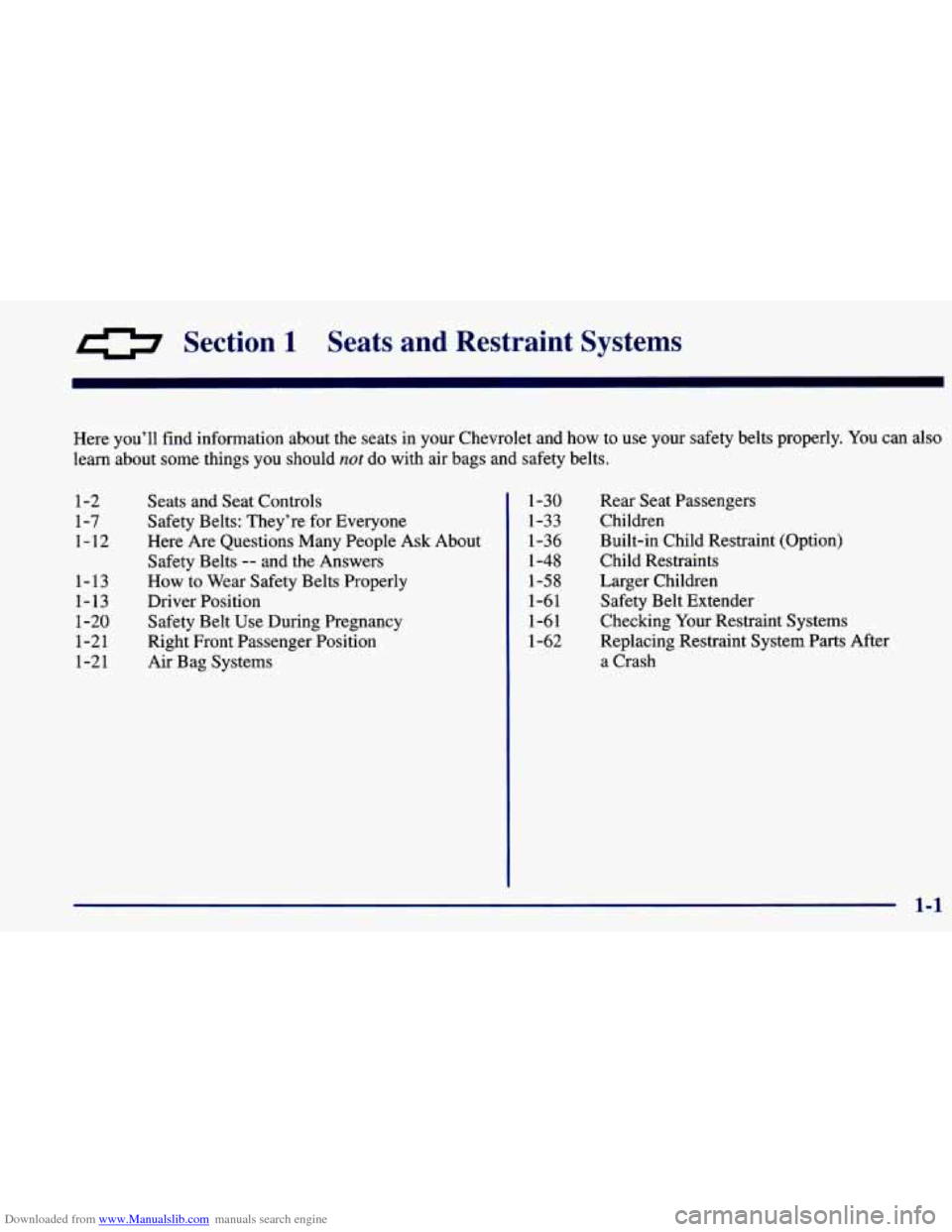
Downloaded from www.Manualslib.com manuals search engine a Section 1 Seats and Restraint Systems
Here you’ll find information about the seats in your Chevrolet and how to use your safety belts properly. You can also
learn about some things you should
not do with air bags and safety belts.
1-2 1-7
1-12
1-13
1-13
1-20
1-21
1-21 Seats
and Seat Controls
Safety Belts: They’re for Everyone
Here Are Questions Many People Ask About
Safety Belts
-- and the Answers
How to Wear Safety Belts Properly
Driver Position
Safety Belt Use During Pregnancy
Right Front Passenger Position
Air Bag Systems 1-30
1-33
1-36 1-48
1-58
1-61
1-61
1-62 Rear
Seat Passengers
Children
Built-in Child Restraint (Option)
Child Restraints
Larger Children
Safety Belt Extender
Checking Your Restraint Systems
Replacing Restraint System Parts After
a Crash
Page 19 of 364
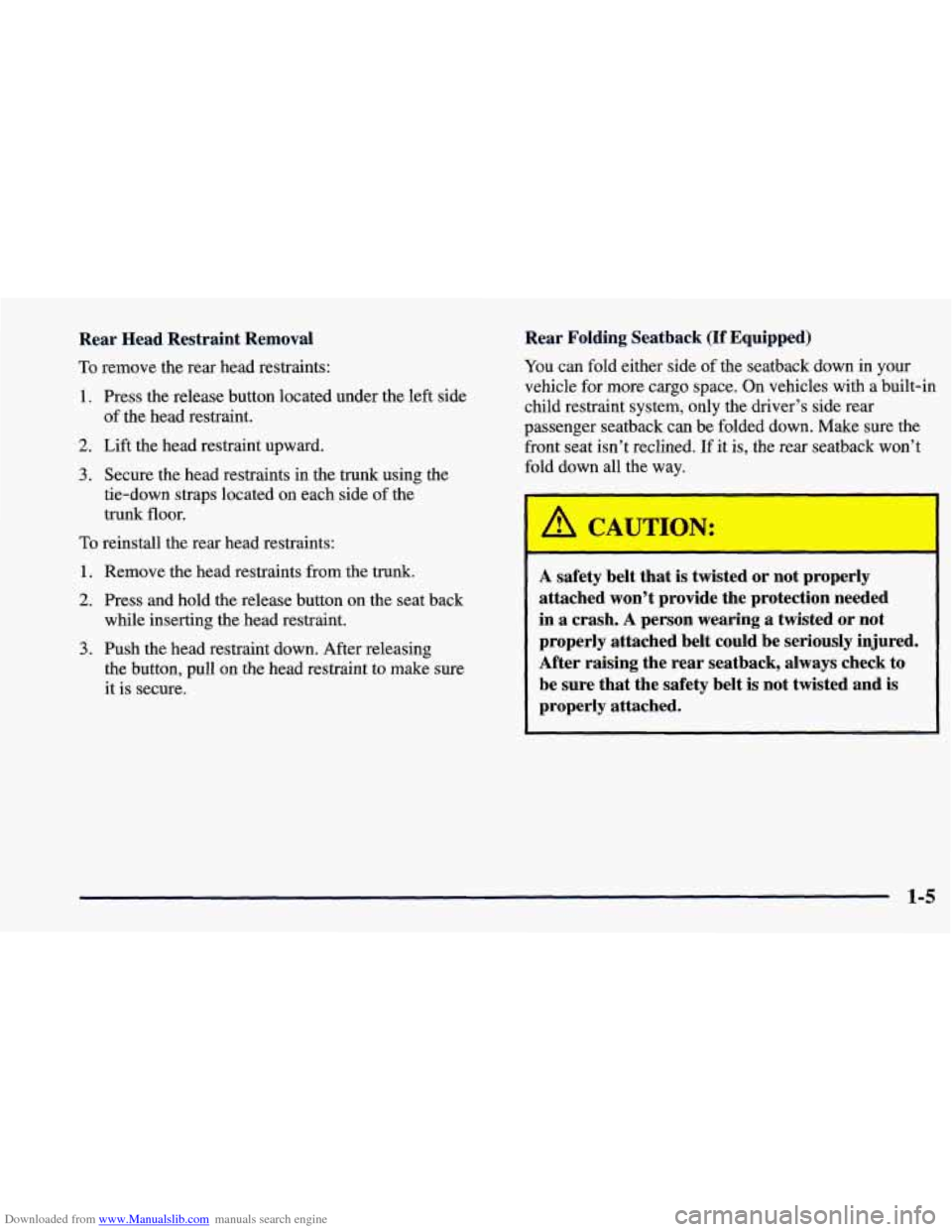
Downloaded from www.Manualslib.com manuals search engine Rear Head Restraint Removal
To remove the rear head restraints:
1. Press the release button located under the left side
of the head restraint.
2. Lift the head restraint upward.
3. Secure the head restraints in the trunk using the
tie-down straps located
on each side of the
trunk floor.
To reinstall the rear head restraints:
1. Remove the head restraints from the trunk.
2. Press and hold the release button on the seat back
while inserting the head restraint.
3. Push the head restraint down. After releasing
the button, pull on the head restraint to make sure
it is secure.
Rear Folding Seatback (If Equipped)
You can fold either side of the seatback down in your
vehicle for more cargo space. On vehicles with
a built-in
child restraint system, only the driver’s side rear
passenger seatback can be folded down. Make sure the
front seat isn’t reclined. If it is, the rear seatback won’t
fold down all the way.
A safety belt that is twisted or not properly
attached won’t provide the protection needed
in a crash.
A person wearing a twisted or not
properly attached belt could be seriously injured.
After raising the rear seatback, always check to
be sure that the safety belt is not twisted and is
properly attached.
1-5
Page 20 of 364
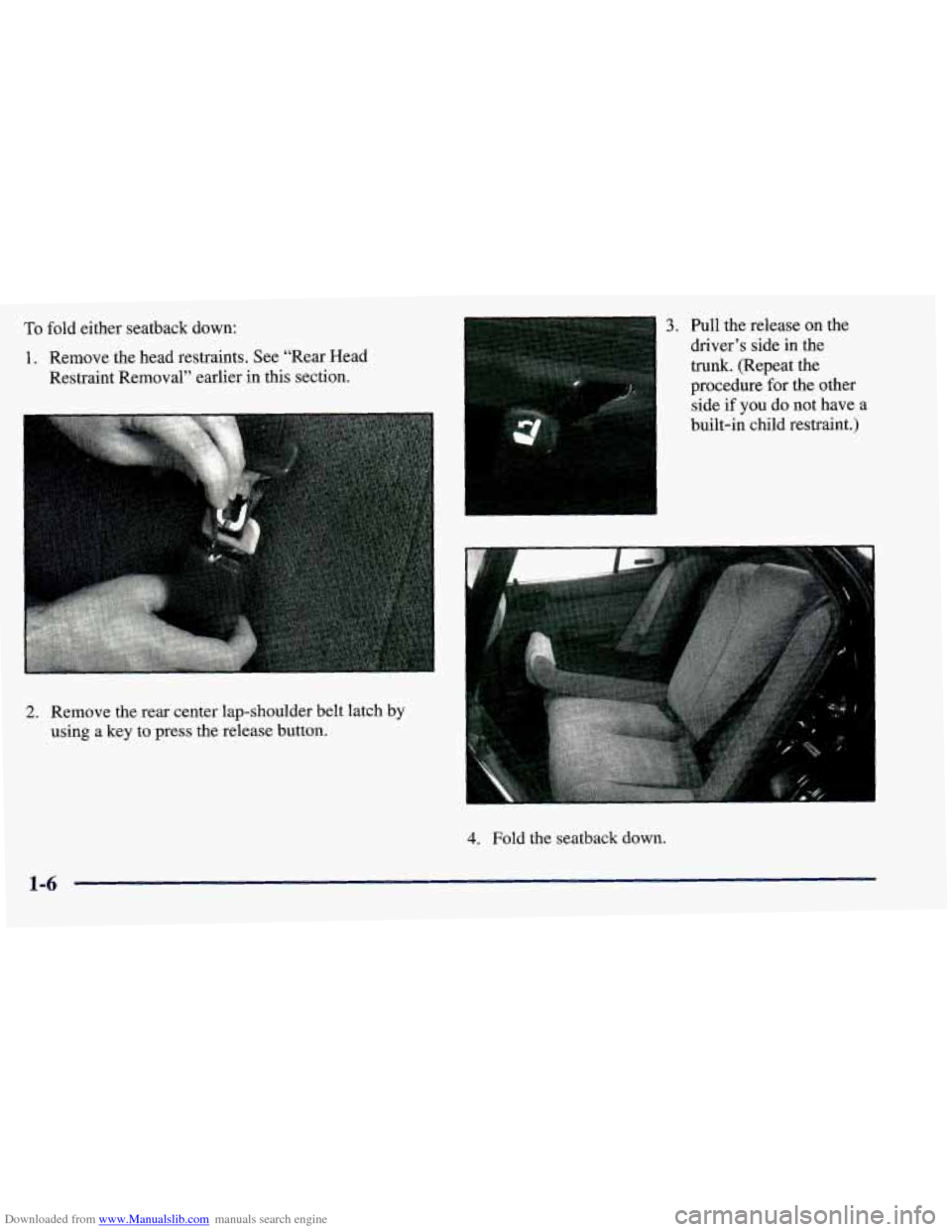
Downloaded from www.Manualslib.com manuals search engine To fold either seatback down:
1. Remove the head restraints. See “Rear Head
Restraint Removal” earlier in this section.
2. Remove the rear center lap-shoulder belt latch by
using a key to press the release button.
3. Pull the release on the
driver’s side in the
trunk. (Repeat the
procedure for the other
side if
you do not have a
built-in child restraint.)
4. Fold the seatback down.
Page 27 of 364
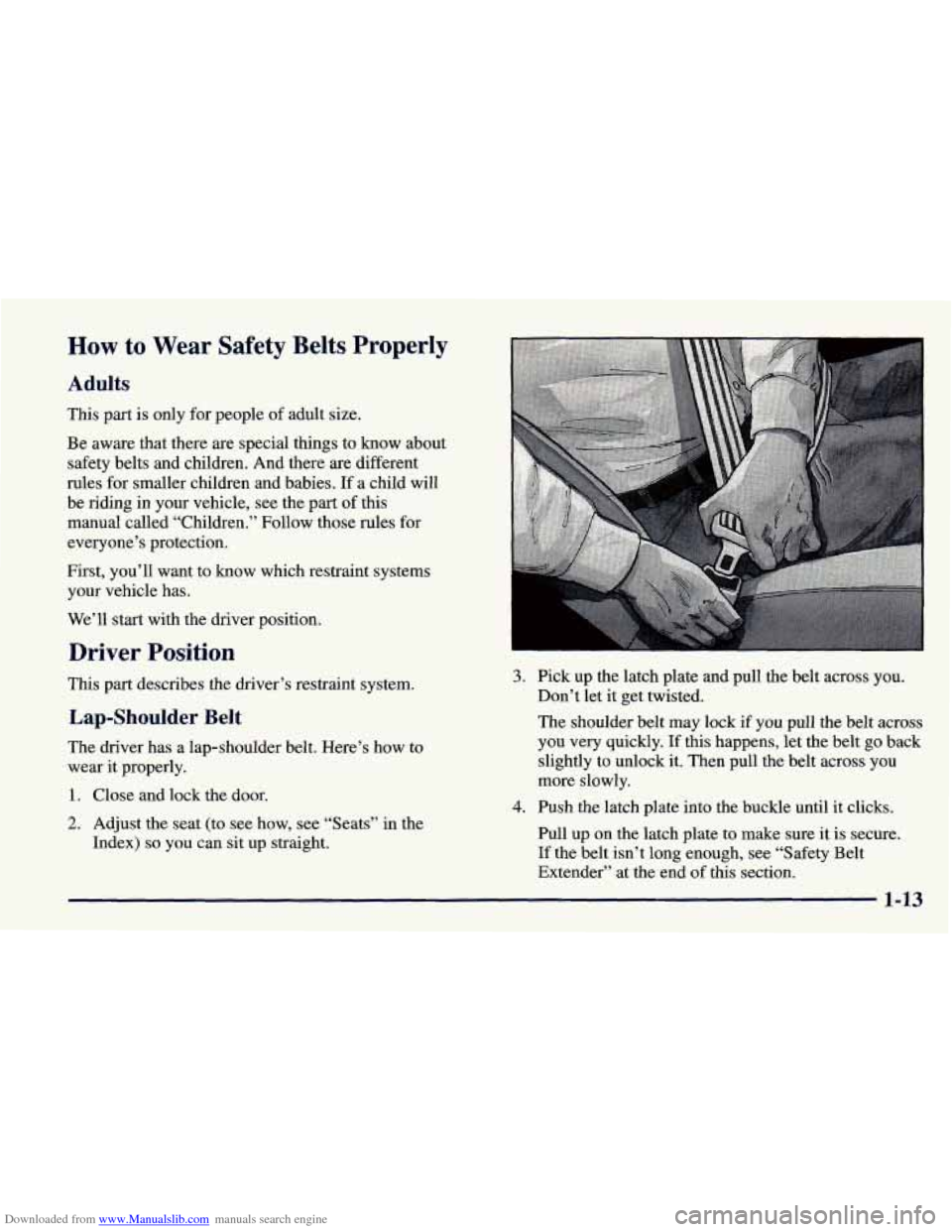
Downloaded from www.Manualslib.com manuals search engine How to Wear Safety Belts Properly
Adults
This part is only for people of adult size.
Be aware that there are special things to know about
safety belts and children. And there
are different
rules for smaller children and babies. If a child will
be riding in your vehicle, see the part
of this
manual called “Children.” Follow those rules for
everyone’s protection.
First, you’ll want to know which restraint systems
your vehicle has.
We’ll start with the driver position.
Driver Position
This part describes the driver’s restraint system.
Lap-Shoulder Belt
The driver has a lap-shoulder belt. Here’s how to
wear it properly.
1. Close and lock the door.
2. Adjust the seat (to see how, see “Seats” in the
Index)
so you can sit up straight.
I
3. Pick up the latch plate and pull the belt across you.
Don’t let it get twisted.
The shoulder belt may lock if you pull the belt across
you very quickly. If this happens, let the belt go back
slightly to unlock it. Then pull the belt across you
more slowly.
4. Push the latch plate into the buckle until it clicks.
Pull
up on the latch plate to make sure it is secure.
If the belt isn’t long enough, see “Safety Belt
Extender” at the end
of this section.
1-13
Page 35 of 364
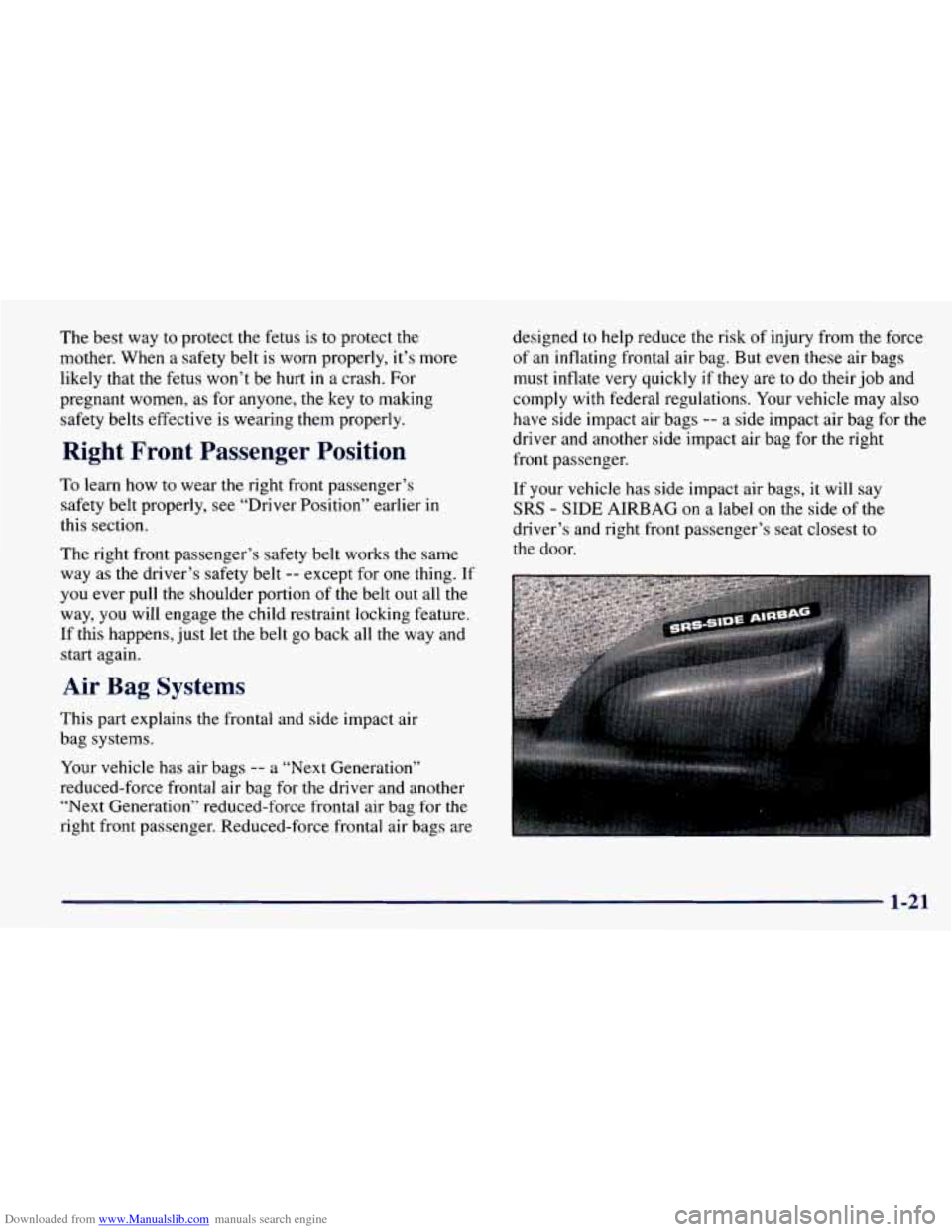
Downloaded from www.Manualslib.com manuals search engine The best way to protect the fetus is to protect the
mother. When a safety belt is worn properly, it’s more
likely that the fetus won’t be hurt
in a crash. For
pregnant women, as for anyone, the key to making
safety belts effective is wearing them properly.
Right Front Passenger Positi(- -I
To learn how to wear the right front passenger’s
safety belt properly, see “Driver Position” earlier in
this section.
The right front passenger’s safety belt works the same
way as the driver’s safety belt
-- except for one thing. If
you ever pull the shoulder portion of the belt out all the
way,
you will engage the child restraint locking feature.
If this happens, just let the belt
go back all the way and
start again.
Air Bag Systems
This part explains the frontal and side impact air
bag systems.
Your vehicle has air bags
-- a “Next Generation”
reduced-force frontal air bag for
the driver and another
“Next Generation” reduced-force frontal air bag for the
right front passenger. Reduced-force frontal air bags are designed
to help reduce the risk of injury from the force
of an inflating frontal air bag. But even these air bags
must inflate
very quickly if they are to do their job and
comply with federal regulations. Your vehicle may also
have side impact air bags
-- a side impact air bag for the
driver and another side impact air bag for the right
front passenger.
If your vehicle has side impact air bags, it will say
SRS
- SIDE AIRBAG on a label on the side of the
driver’s and right front passenger’s seat closest to
the door.
1-21
Page 37 of 364
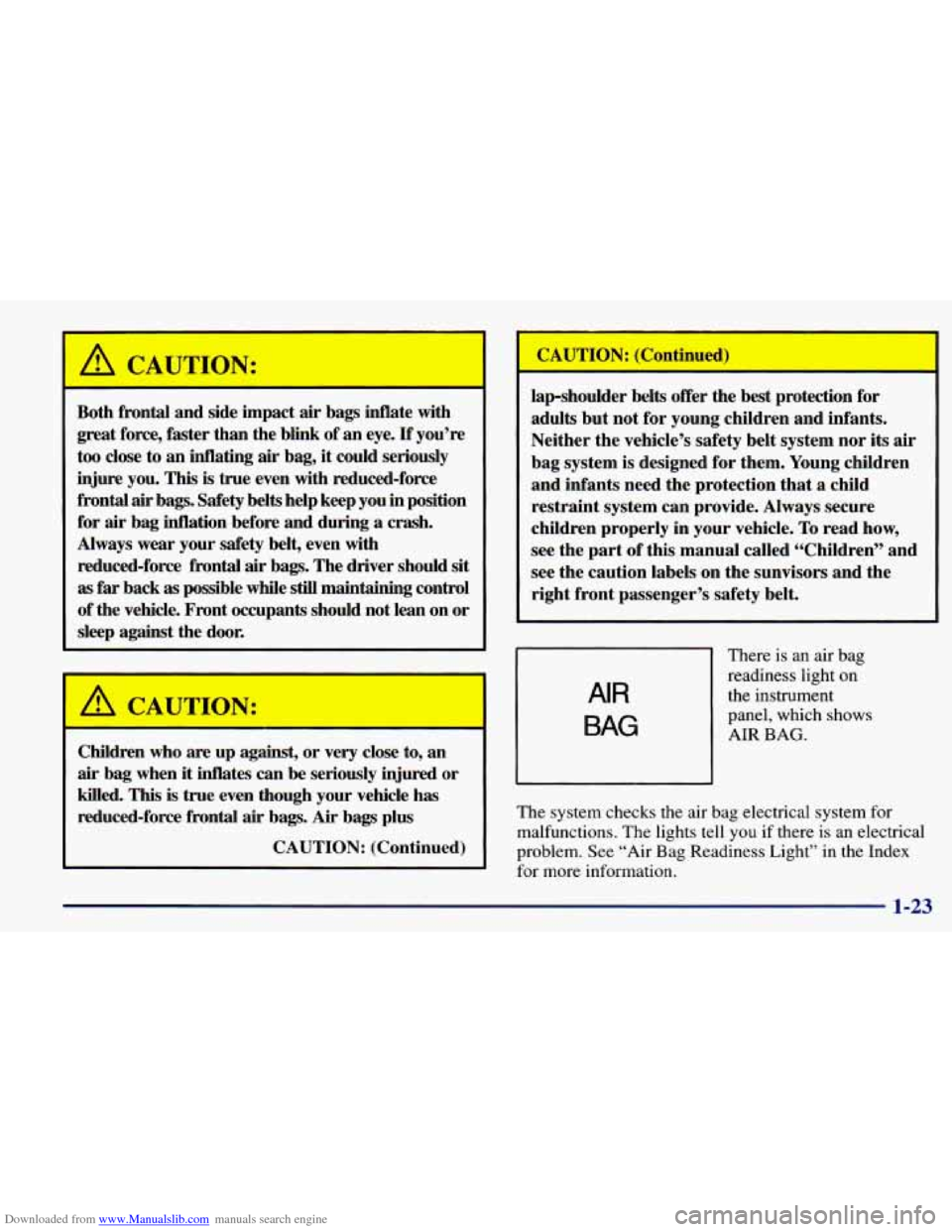
Downloaded from www.Manualslib.com manuals search engine A CAUTION:
Both frontal and side impact air bags inflate with
great force, faster than the blink of an eye.
If you’re
too close to an inflating
air bag, it could seriously
injure you.
This is true even with reduced-force
frontal
air bags. Safety belts help keep you in position
for
air bag idation before and during a crash.
Always
wear your safety belt, even with
reduced-force frontal
air bags. The driver should sit
as far back as possible while still maintaining control
of the vehicle. Front occupants should not lean on or
sleep against the door.
’ A CAU-ION:
Children who are up against, or very close to, an
air bag when it inflates can be seriously injured or
killed. This is true even though your vehicle
has
reduced-force frontal air bags. Air bags plus
CAUTION: (Continued)
I
lap-shoulder belts offer the best protection for
adults but not for young children and infants.
Neither the vehicle’s safety belt system nor its air
bag system is designed for them. Young children
and infants need the protection that a child
restraint system can provide. Always secure
children properly in your vehicle. To read how,
see the part of this manual called “Children” and
see the caution labels on the sunvisors and the
right front passenger’s safety belt.
AIR
BAG
There is an air bag
readiness light on
the instrument
panel, which shows
AIR BAG.
The system checks the air bag electrical system for
malfunctions.
The lights tell you if there is an electrical
problem. See “Air Bag Readiness Light” in the Index
for more information.
1-23
Page 47 of 364
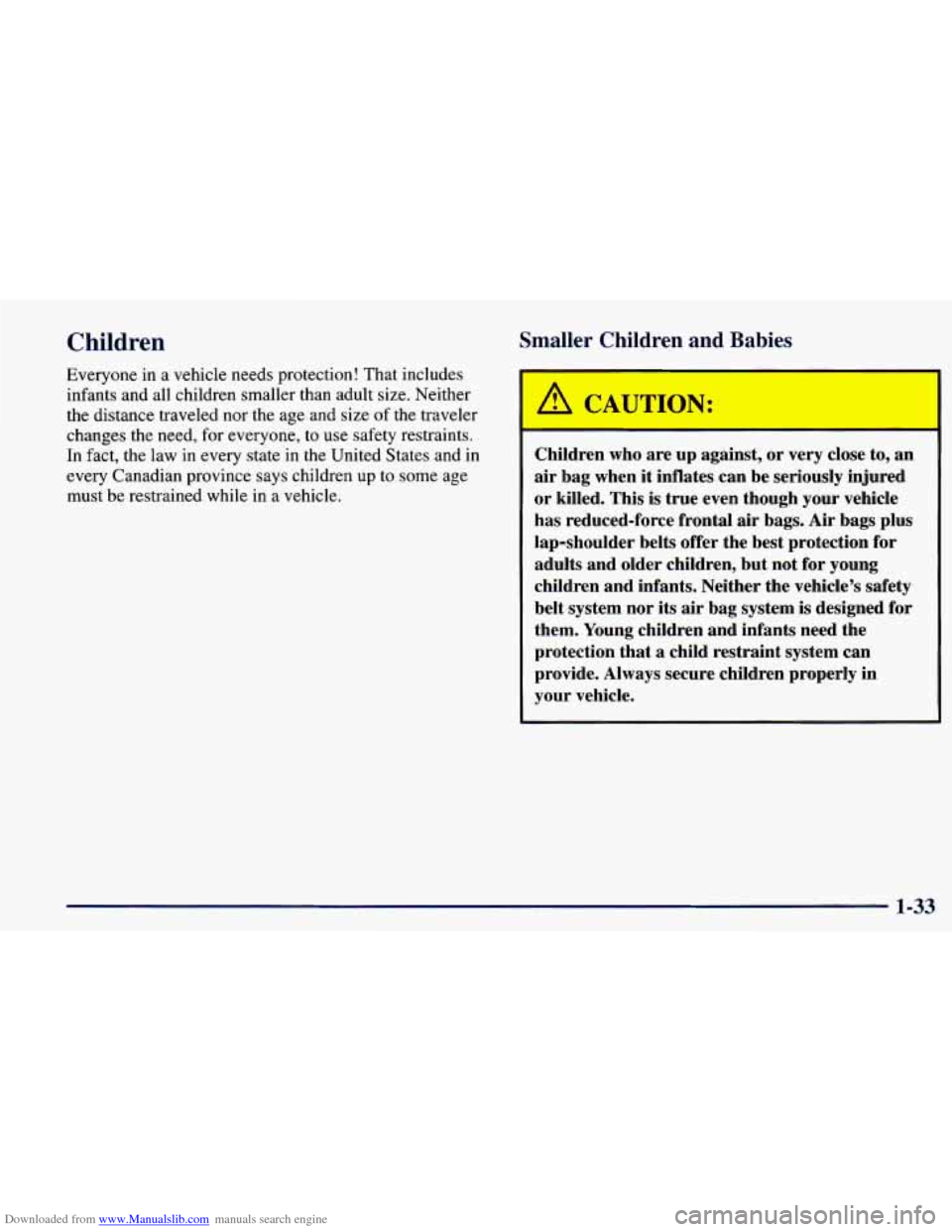
Downloaded from www.Manualslib.com manuals search engine Children
Everyone in a vehicle needs protection! That includes
infants and all children smaller than adult size. Neither
the distance traveled nor the age and size
of the traveler
changes the need, for everyone, to use safety restraints.
In fact, the law in every state in the United States and in
every Canadian province says children up to some age
must
be restrained while in a vehicle.
I ?r Childr-7 anA R-3ies
Children who are up against, or very close to, an
air bag when it inflates can be seriously injured
or killed. This is true even though your vehicle
has reduced-force frontal air bags. Air bags plus
lap-shoulder belts offer the best protection for
adults and older children, but not for young
children and infants. Neither the vehicle’s safety
belt system nor its air bag system is designed for
them. Young children and infants need the
protection that
a child restraint system can
provide. Always secure children properly in
your vehicle.
1-33
Page 48 of 364
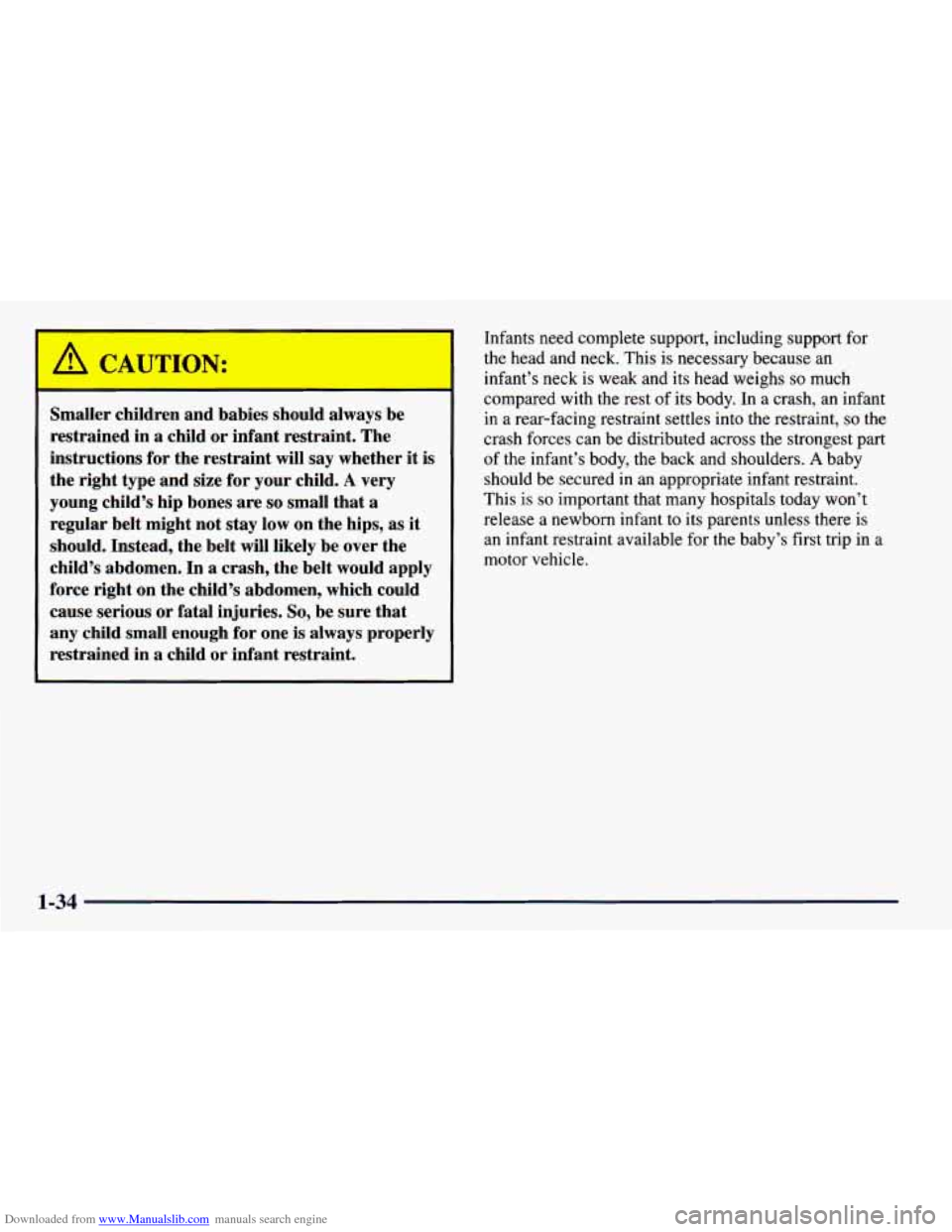
Downloaded from www.Manualslib.com manuals search engine /d CAUTION:
--
Smaller chi: ‘en and babies should always be
restrained in a child or infant restraint. The
instructions for the restraint will say whether it
is
the right type and size for your child. A very
young child’s hip bones are
so small that a
regular belt might not stay low on the hips, as it
should. Instead, the belt will likely be over the
child’s abdomen. In
a crash, the belt would apply
force right
on the child’s abdomen, which could
cause serious
or fatal injuries. So, be sure that
any child small enough for one
is always properly
restrained in a child
or infant restraint.
Infants need complete support, including support for
the head and neck. This is necessary because an
infant’s neck is weak and its head weighs
so much
compared with the rest
of its body. In a crash, an infant
in a rear-facing restraint settles into the restraint,
so the
crash forces can be distributed across the strongest part
of the infant’s body, the back and shoulders.
A baby
should be secured in an appropriate infant restraint.
This is
so important that many hospitals today won’t
release a newborn infant to its parents unless there is
an infant restraint available for the baby’s first trip in a
motor vehicle,
1-34
Page 50 of 364
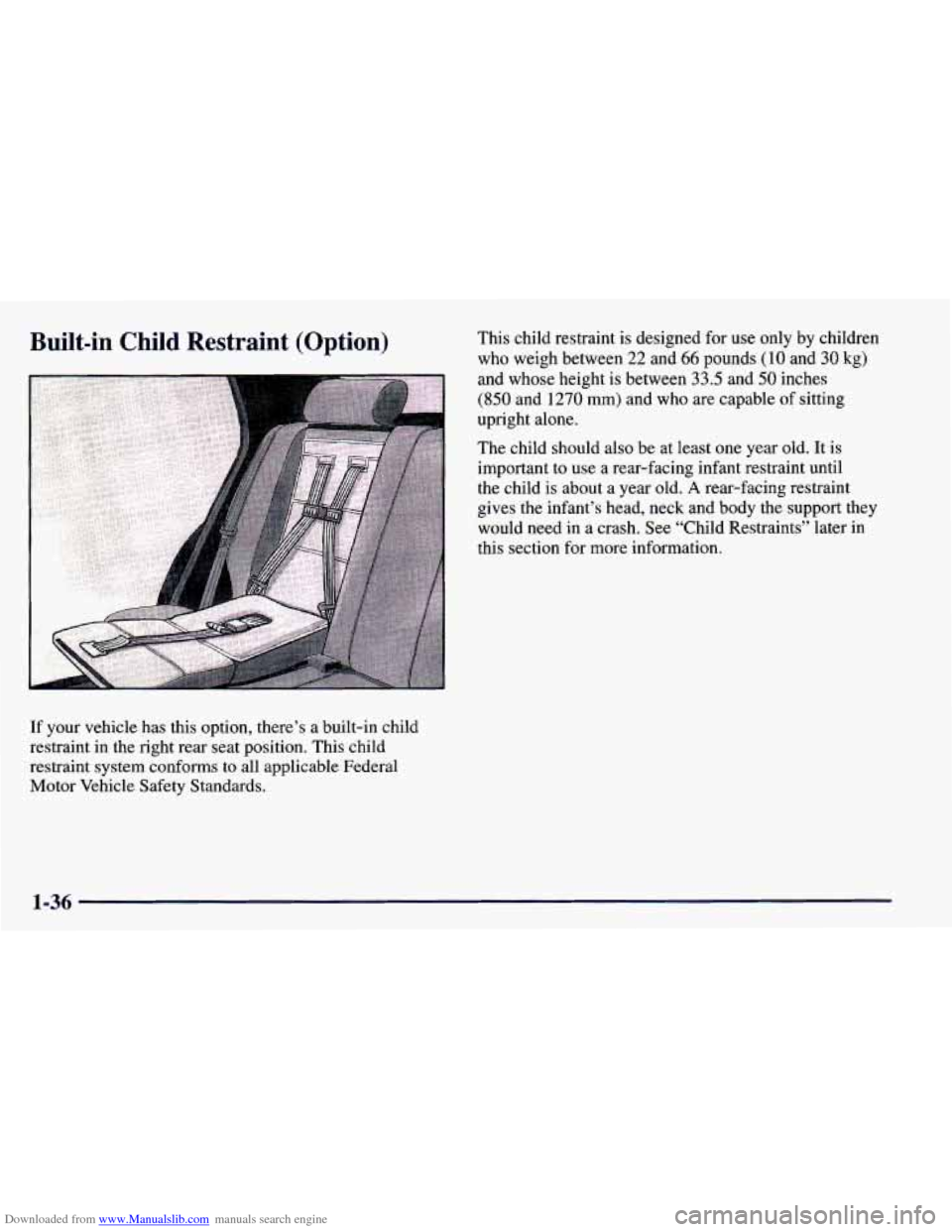
Downloaded from www.Manualslib.com manuals search engine Built-in Child Restraint (Option)
If your vehicle has this option, there’s a built-in child
restraint in the right rear seat position. This child
restraint system conforms to all applicable Federal
Motor Vehicle Safety Standards. This
child restraint is designed for use only by children
who weigh between
22 and 66 pounds (10 and 30 kg)
and whose height is between 33.5 and 50 inches
(850 and
1270 mm) and who are capable of sitting
upright alone.
The child should also be
at least one year old. It is
important to use
a rear-facing infant restraint until
the child
is about a year old. A rear-facing restraint
gives the infant’s head, neck and body the support they
would need
in a crash. See “Child Restraints” later in
this section for more information.
1-36
Page 51 of 364
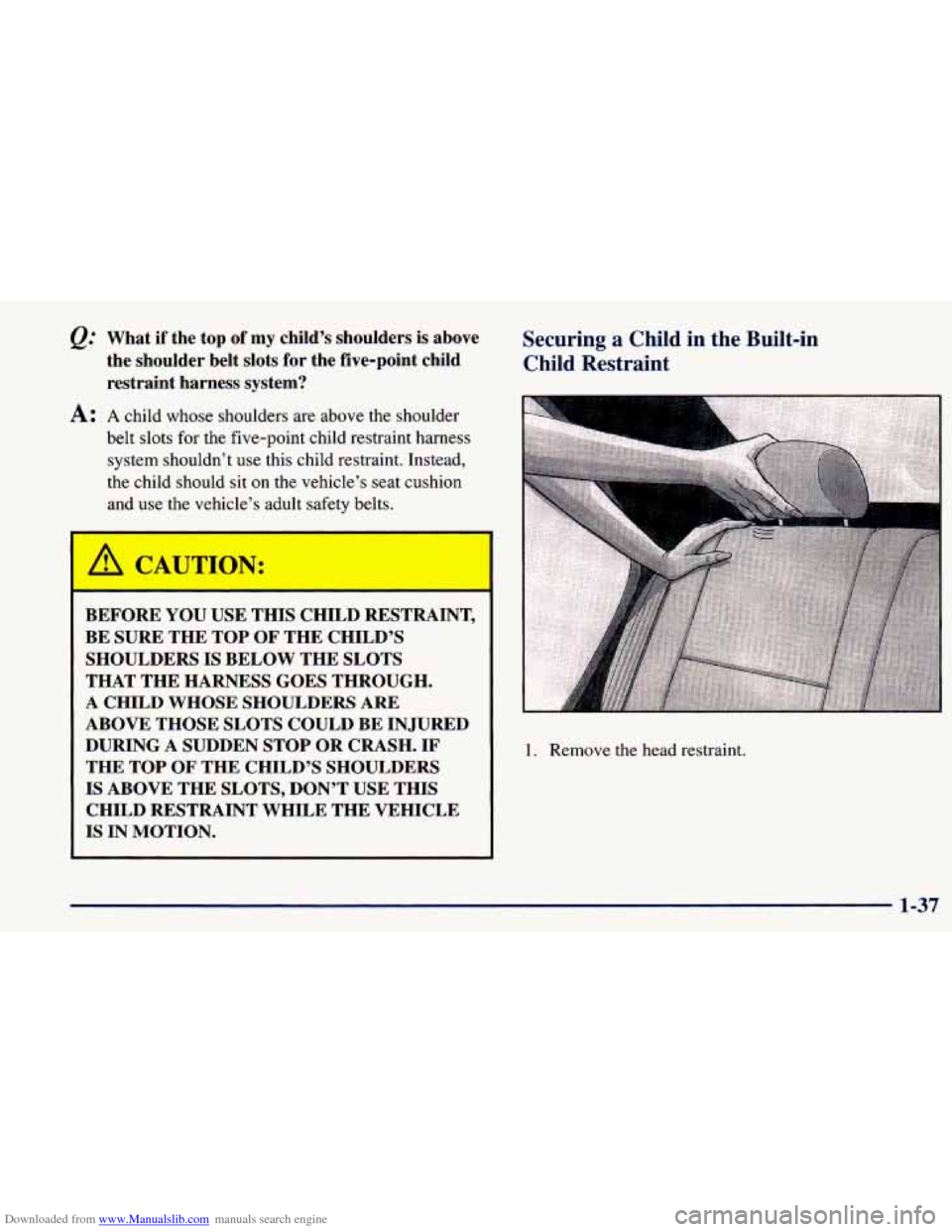
Downloaded from www.Manualslib.com manuals search engine Q: What if the top of my child’s shoulders is above
the shoulder belt slots for the five-point child
restraint harness system?
A: A child whose shoulders are above the shoulder
belt slots for the five-point child restraint harness
system shouldn’t use this child restraint. Instead,
the child should sit on the vehicle’s seat cushion
and use the vehicle’s adult safety belts.
-
A CAUTION:
I
BEFORE YOU USE THIS CHILD RESTRAINT,
BE SURE THE TOP
OF THE CHILD’S
SHOULDERS IS BELOW THE SLOTS
THAT THE HARNESS GOES THROUGH.
A CHILD WHOSE SHOULDERS ARE
ABOVE THOSE SLOTS COULD BE
IN JURED
DURING
A SUDDEN STOP OR CRASH. IF
THE TOP OF THE CHILD’S SHOULDERS
IS ABOVE THE SLOTS, DON’T USE THIS
CHILD RESTRAINT WHILE THE VEHICLE
IS IN MOTION.
Securing a Child in the Built-in
Child Restraint
1. Remove the head restraint.
1-37